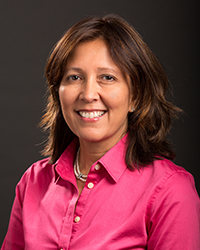
AJR February 2017

|
Regina Hooley, MD
Associate Professor
Vice Chair for Clinical Affairs
Yale Medicine Department of Radiology & Biomedical Imaging
|
Advances in Digital Breast Tomosynthesis
Digital breast tomosynthesis (DBT) improves interpretive performance and will likely replace conventional 2D mammography in clinical practice. Key features of DBT, including technique, clinical implementation, and benign and malignant imaging findings, are discussed in this women’s imaging review piece.
1. Is the combination 2D and DBT radiation dose risky for the patient?
No. Even though the combination two-view 2D and DBT study increases radiation dose by approximately twofold, the combination dose (2D plus DBT) is still below Mammography Quality Standards Act (MQSA) safety limits of 3 mGy/view. Keep in mind that the added DBT dose is equivalent to approximately one to two months of annual background radiation in accordance with U.S. standards. Still, radiation dose is cumulative over time, so it’s prudent to limit exposure whenever possible, particularly because many women have an annual mammogram. Some DBT units produce a synthesized 2D mammogram reconstructed from the DBT data to permit obtaining a 2D mammogram (synthesized) plus DBT so that radiation dose is decreased to levels similar to conventional 2D mammography alone.
The two-view combination 2D plus DBT is the most common image acquisition protocol used among U.S. facilities. However, there are other image protocols available that are also designed to decrease dose. For example, a DBT can be performed with only a single view even though diagnostic accuracy has been shown not to be as high as two-view DBT. In addition, at least one manufacturer recently obtained Food and Drug Administration (FDA) approval for performing mammography with DBT only.
2. In women who undergo DBT and also have dense breast tissue, is supplemental screening whole-breast ultrasound necessary?
That’s an important question and no one knows for sure because there is limited data. DBT is an excellent screening tool and we know that the overall supplemental cancer detection rate (in addition to 2D mammography alone) is approximately 1–3/1000 women screened across all breast densities. On the other hand, the supplemental cancer yield for screening ultrasound in women with dense breast tissue is 2–4/1000 women screened. So we know that screening ultrasound detects more cancers, but it is a completely separate exam, unlike DBT which can be done at the same time as the routine mammogram (or can replace the routine 2D mammogram if a synthesized mammogram is obtained) and takes only seconds longer.
The question is, then, who can benefit the most from screening breast ultrasound in addition to DBT? It is possible that women with heterogeneous or extremely dense breasts who are at high risk and do not want MRI screening could benefit the most, but more clinical investigation and data are needed.
3. Is there a downside to using DBT rather than 2D mammography?
The downside is the capital required by practices to invest in the DBT technology. DBT offers superior screening and diagnostic mammography. Not only are sensitivity and specificity simultaneously improved, but clinical workflow is also enhanced. More cancers are detected, fewer women are recalled for an abnormal finding on screening, and fewer views are required when diagnostic mammography is performed.
Unfortunately, insurance companies do not uniformly reimburse for DBT and women may have to pay out-of-pocket for this technology. This can discourage women and influence them not to choose DBT. Some practices charge extra for DBT, while others take insurance although DBT often applies to one’s deductible. Other practices (including my practice at Yale) currently do not charge for DBT so that all women benefit equally, but this does create stress on practice resources.
4. Is the addition reading time required to analyze the 2D plus the DBT mammography cost-effective?
Yes
5. Is DBT effective in diagnosing disease as opposed to screening?
Yes
6. Are there any patients who would not benefit from DBT?
Not really
7. What’s the most important information revealed in this review?
DBT will rapidly change the practice standard of mammography. As of Jan. 1, 2017, 34% of all MQSA certified facilities in the United States had at least one DBT mammography unit (per FDA website).
Do you have a story idea for InPractice?
Contact Cheryl S. Merrill, Director of Publications, at cmerrill@arrs.org for more information.